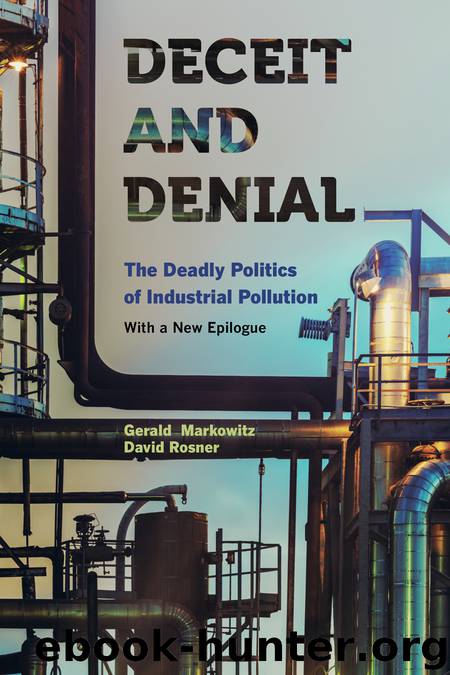Deceit and Denial by Markowitz Gerald

Author:Markowitz, Gerald
Language: eng
Format: epub
ISBN: 9780520275829
Publisher: University of California Press
THE DEVELOPMENT OF THE PRECAUTIONARY PRINCIPLE
Dr. Irving Selikoff and industry representatives alike recognized that the battle over vinyl chloride was not about the dangers and carcinogenic effects of one substance. Rather, it was what the prestigious business periodical Fortune called “the tip of an enormous regulatory iceberg.”103 Coming shortly after the formation of the EPA, NIOSH, OSHA, and the Consumer Product Safety Commission, the storm over vinyl chloride forced regulators, industry, consumer groups, and labor to confront “all the indirect costs of running a modern economy.”
Sheldon W. Samuels, the health director of the Industrial Union Department of the AFL-CIO, argued that labor saw the battle as an attempt to put an end to industry's “free ride on social costs.” Fortune magazine, on the other hand, suggested that it was as important to prevent the death of an industry as it was to prevent workers’ deaths: “If government allows workers to be exposed to the gas, some of them may die. If it eliminates all exposure a valuable industry may disappear.”104 Vinyl chloride presented a situation where “medical and economic considerations collide[d] head-on.”105
Yet it was the language of science, rather than politics or economics, that dominated the debate about the causes of cancer, the means of prevention, and the responsibilities of the government. Consumers, labor, and public health advocates argued that there was no level at which exposure to carcinogens could be presumed effective in preventing cancers. “Advocates of the ‘no-detectable level’ argued for the so-called ‘one-hit’ theory of cancer causation,” wrote Paul Weaver in Fortune, describing the position that there was “no such thing as a risk-free exposure to a carcinogen.” The industry, on the other hand, argued that “cancers appear when the immune system breaks down.” A healthy immune system had to be weakened before a cancer could develop. Industry held that “what a carcinogen does is to weaken the immune system” and that the “weakening process requires a certain level of dose.” According to this interpretation, it was possible that there was “a risk-free level of exposure.”106
This debate over whether there were safe levels of exposure to vinyl chloride forced the new regulatory agencies to formulate the principles that would guide government's role in economic, scientific, and political decisions. The argument that played out over vinyl chloride is played out today over all toxic substances.
The vinyl chloride issue brought to the fore the question first raised during the tetraethyl lead controversy a half century before: Should industry be asked to prove that a substance was safe before introducing it into the environment, or should society be forced to prove it dangerous before banning it? Since the tetraethyl lead crisis, industry had largely prevailed in this debate, but vinyl chloride represented a whole new class of chemical products of enormous importance to the chemical industry and, perhaps, society.
Writing in the Wall Street Journal in October 1974, Barry Kramer described the stakes. If the labor and consumer advocates’ view prevailed, Kramer observed, “industry will no longer be able to assume blithely that untested chemicals .
Download
This site does not store any files on its server. We only index and link to content provided by other sites. Please contact the content providers to delete copyright contents if any and email us, we'll remove relevant links or contents immediately.
Pale Blue Dot by Carl Sagan(3995)
The Rules Do Not Apply by Ariel Levy(3897)
Goodbye Paradise(2949)
Delivering Happiness by Tony Hsieh(2917)
Liar's Poker by Michael Lewis(2805)
Into Thin Air by Jon Krakauer(2695)
Purple Cow by Seth Godin(2694)
Ogilvy on Advertising by David Ogilvy(2677)
Rogue Trader by Leeson Nick(2469)
The Airbnb Story by Leigh Gallagher(2363)
The Social Psychology of Inequality by Unknown(2304)
The Mind Map Book by Tony Buzan(2074)
Six Billion Shoppers by Porter Erisman(1995)
Bossypants by Tina Fey(1982)
Claridge's: The Cookbook by Nail Martyn & Erickson Meredith(1958)
All the President's Men by Carl Bernstein & Bob Woodward(1955)
Master of the Game by Sidney Sheldon(1877)
Alibaba by Duncan Clark(1751)
Wild Ride by Adam Lashinsky(1655)
